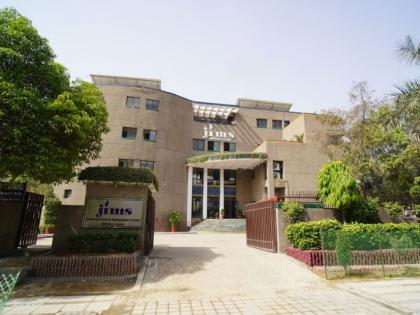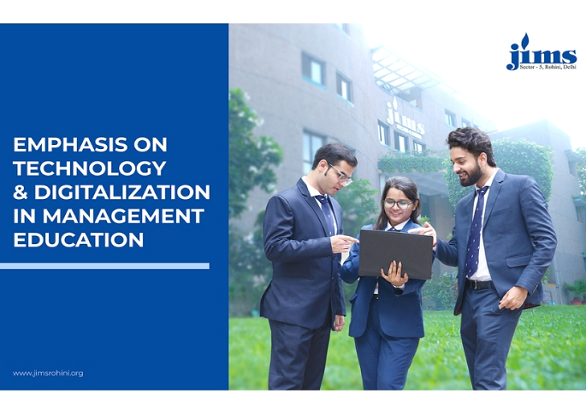Emphasis on Technology and Digitalization in Management Education
By Impact Desk | Updated: November 21, 2024 11:37 IST2024-11-21T11:36:50+5:302024-11-21T11:37:05+5:30
Digital technology has created a revolution in the industries, turning outdated ways of working into data-driven, more efficient substitutes. ...

Emphasis on Technology and Digitalization in Management Education
Digital technology has created a revolution in the industries, turning outdated ways of working into data-driven, more efficient substitutes. In management education, particularly at PGDM (Post Graduate Diploma in Management) institutes, technology integration is paramount. This technological shift in teaching enhances theoretical knowledge and practical skill sets. It better prepares the candidates to carve a niche for themselves in the digitized corporate world.
The Role of Digitalization in Management Education
Technology plays an integral role in imparting a new twist to management education and thus provides students with advanced tools that conform to the current standards. The advent of digital tools such as virtual learning environments, data analytics software, online resources, and tools has changed the way people access academic content, making learning more adaptable and accessible. Blended Learning and Online Platforms: The management institutes have adopted blended learning, a method that merges the traditional classroom experience with online modules. The approach allows for remote access of course work and other learning materials, thus providing maximum flexibility. Blended learning also conditions the students for working in a remote capacity, a skill much sought after in today's corporate environment.
Data-Driven Decision-Making: With the increase in digitalization comes access to data on an unprecedented scale. Today's management programs interlace data analytics and business intelligence within their course offerings, allowing students to make astute, data-driven decisions. Students who are able to read and interpret analytics gain insight into trends, understand the dynamics of the market, and then make informed decisions. Such are the skills that a managerial aspirant must acquire.
Simulation and Gamification: Simulation tools enable students to undertake experiential learning that brings real-life problems into the classroom. For example, simulations in finance, marketing, and supply chain management allow students to take theoretical concepts into a risk-free context. Gamification gives an interactive face to learning, with the result that engagement and retention are enhanced because students can address business challenges using a structured play-like format.
Artificial Intelligence and Machine Learning: AI and machine learning provide in-depth data analytics that form the backbone of predictive analytics, automation, and decision-making tools. It is becoming essential for management students to understand AI technologies to help strategize task automation and data processing that underlie the operations of the modern enterprise.
Digital Marketing and Social Media Management: In the age of ever-evolving IT functions and online networking, digital marketing is the way for management students to understand and practice SEO, content, and strategy for different marketing and social media platforms. It prepares aspirants to leverage digital platforms and carve their space in a digital marketing role.
Financial Technology (FinTech): Fintech has disrupted the entire finance sector. Along this vein, courses in blockchain and digital payments—online banking, and banking in general—offer insights into technology that will shape how they bank, trade, invest, and even lend and borrow in the years to come. In turn, it prepares them for a career that spans from traditional to digital finance.
Supply Chain Management and ERP Systems: The growing interconnectedness of economies and supply chains have made them very complex and challenging to navigate. Enterprises are looking for professionals who are aware of how supply functions can be integrated within an Enterprise Resource Planning (ERP) system—a single integrated approach to running a business. Amid globalization, understanding and working with global distribution have grown so complex that students are being taught to create their supply chain map.
Cloud Computing and Cybersecurity: Cloud Computing. Students are increasingly relying on digital resources, which are predominantly hosted in the cloud. It, therefore, becomes crucial to understand cloud computing and security, i.e., cloud infrastructure and data protection.
Benefits of Digitalization for Students and Institutions
More readily available learning resources and opportunities to upskill are part and parcel of modern digitalization for students. Online resources, virtual labs, and digital libraries deliver the complete courseware, going beyond the conventional textbook. On the other side, the means of offering increasingly diverse courses, varied pedagogies, and multiple delivery mechanisms becomes accessible to the institutes. Digitalization helps bring about a scalable model in education, affording colleges the capability to reach more people with considerate ease, conduct evaluations, and monitor the performance of students on real-time levels.
Conclusion
In the ever-changing business environment of the modern world, technology and digitalization are no longer optional; these have actually become a part of the very essence of delivering management education. Management institutes are thus adapting to these changes and providing for such learning environments as reflect the modern workplace in order to prepare their students for life in a technology-driven world. Such integration not only makes for better learning of students but better-prepares them to fulfil the demands of an ever-changing digital world in the larger market.
Open in app
